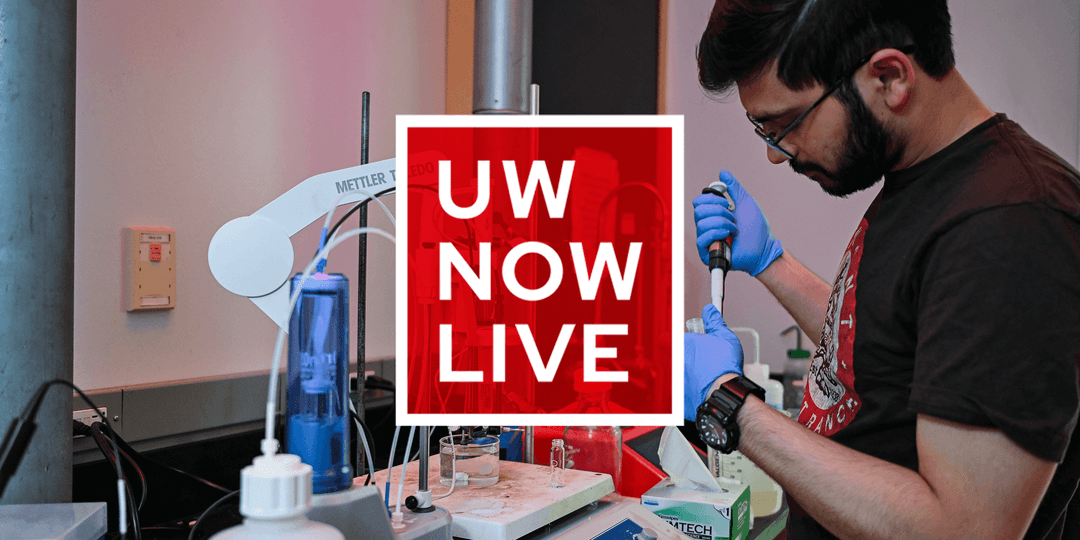If you want to see the value of federal research grants, consider Alzheimer’s disease.
According to Sterling Johnson, an Alzheimer’s researcher, the National Institutes of Health (NIH) spend about $3 billion a year on Alzheimer’s disease studies. That’s a lot of money. But the U.S. spends $360 billion a year on care for Alzheimer’s patients, as well as $347 billion in uncompensated caregiving. That is a lot more money. One year of care is worth more than 120 years of research. And there’s no way to lower the amount the country spends on care until researchers discover better treatments.
On the April 15, 2025, UW Now livestream, Johnson and other UW–Madison research leaders spoke with host Mike Knetter about the importance of grants and the danger posed by the federal government’s recently announced plan to cap funding for indirect costs. Knetter’s guests included Dorota Grejner-Brzezinska, the UW’s vice chancellor for research; Anjon Audhya, senior associate dean for basic research, biotechnology, and graduate studies; and Johnson, the Jean R. Finley Professor of Geriatrics and Dementia and director of the Wisconsin Registry for Alzheimer’s Prevention.
Grejner-Brzezinska noted that UW–Madison is currently one of the nation’s leaders when it comes to research — out of 920 universities that receive research funding, UW–Madison ranks sixth in terms of expenditures. That funding leads to economic growth.
“Every single dollar of NIH funding across the country generated approximately $2.46 of economic activity,” she said. “That’s a really great ROI.”
She noted that the UW’s indirect cost is currently 55.5 percent, but this is a figure that the university negotiated with the federal government. “I want to emphasize this is not a number that UW comes up with. This is the federally mandated or negotiated number, which is subject to reviews every few years,” she said. “This is not a gift to the university. This is the real cost which we need to recover.”
Audhya talked about research as a core part of the UW’s purpose. “Our mission is really to innovate, collaborate, and contribute to the fundamental discovery that’s necessary to advance knowledge, teach and mentor learners, and translate the discoveries to promote health in Wisconsin and beyond,” he said.
He explained why indirect costs are important to that mission. “You need the combination of direct as well as indirect costs to be able to effectively do the research that we do here at the University of Wisconsin–Madison,” he said. “The way that I like to try to explain this is as a simple analogy. You travel to a grocery store; you purchase a wonderful steak; you want to bring it home for your family and have a wonderful dinner. Those are the direct costs that you’re using to purchase that steak. When you get home, probably your first place you go is to your refrigerator to put that steak to maintain its tenderness, its ability to be a great source of nutrients for your family. Those costs to make that refrigerator function, those are the indirect costs.”
Johnson used Alzheimer’s studies as a specific example of the ways that NIH funds can lead to tremendous benefit. NIH-funded research has the medical world closing in on promising treatments for what is, today, an incurable illness.
“There are many, many clinical trials happening and some of these trials are happening here at the UW,” he said. “This is all happening with NIH funding. This is work that industry could not do.”
The guests took questions from viewers, noting the ways in which scientific research benefits American life and the U.S. economy. All this, warned Johnson, could be put at risk by the government’s threats to cap funding.
“The main components of the Wisconsin Alzheimer’s research program, they’re intact and they’re continuing,” he said. “We’re all on edge, though, and there’s worry and doubt, not just in the workforce, but there’s confusion among research participants, wondering if we’re going to stay with them and support them in their journey through this disease.”




